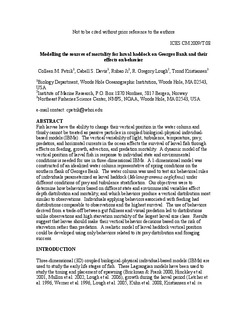Modelling the sources of mortality for larval haddock on Georges Bank and their effects on behavior
Working paper

Åpne
Permanent lenke
http://hdl.handle.net/11250/103020Utgivelsesdato
2009Metadata
Vis full innførselSamlinger
Originalversjon
This report is not to be quoted without prior consultation with the General Secretary.Sammendrag
Fish larvae have the ability to change their vertical position in the water column and
thusly cannot be treated as passive particles in coupled biological-physical individualbased
models (IBMs). The vertical variability of light, turbulence, temperature, prey,
predators, and horizontal currents in the ocean affects the survival of larval fish through
effects on feeding, growth, advection, and predation mortality. A dynamic model of the
vertical position of larval fish in response to individual state and environmental
conditions is needed for use in three-dimensional IBMs. A 1-dimensional model was
constructed of an idealized water column representative of spring conditions on the
southern flank of Georges Bank. The water column was used to test six behavioral rules
of individuals parameterized as larval haddock (Melanogrammus aeglefinus) under
different conditions of prey and turbulence stratification. Our objectives were to
determine how behaviors based on different state and environmental variables affect
depth distribution and mortality, and which behaviors produce a vertical distribution most
similar to observations. Individuals applying behaviors associated with feeding had
distributions comparable to observations and the highest survival. The use of behaviors
derived from a trade-off between gut fullness and visual predation led to distributions
unlike observations and high starvation mortality of the largest larval size class. Results
suggest that larvae should make their vertical behavior decisions based on the risk of
starvation rather than predation. A realistic model of larval haddock vertical position
could be developed using only behaviors related to its prey distribution and foraging
success.